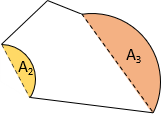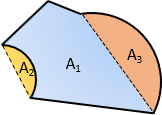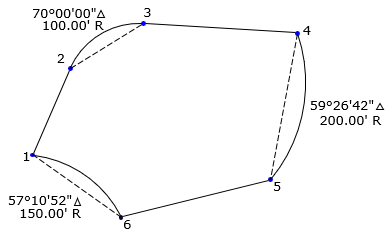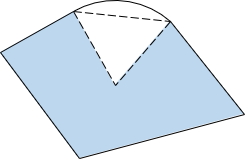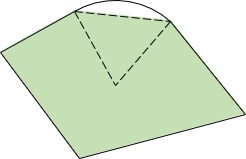2. Traverse with curves
a. Segments and sectors
Area by coordinates is constrained to following straight lines. Where curves are involved, Figure H-3(a), the method returns an area bounded by their chords, Figure H-3(b).
|
|
|
|
Figure H-3 |
|
To obtain the correct area, sector or segment areas are computed and added or subtracted accordingly. For the traverse in Figure H-3(a), the two segment areas are computed, Figure H-4(a), and one subtracted from, the other added to, the area by coordinates, Figure H-4(b).
|
(a) Segments |
(b) ATotal=A1-A2+A3 |
|
Figure H-4 |
|
b. Example area computation
Given the traverse in Figure H-5, determine its area.
|
|
|
Figure H-5 |
In the table below, the points and their coordinates are in the first three columns; their cross-products are in the last two.
| Point | North (ft) | East (ft) | ||
| 1 | 500.00 | 1200.00 | 737,634 | |
| 2 | 614.70 | 1249.70 | 624,850. | 843,243 |
| 3 | 674.76 | 1347.43 | 828,261 | 892,620. |
| 4 | 662.46 | 1552.76 | 1,047,730 | 725,778 |
| 5 | 467.41 | 1516.87 | 1,004,860 | 633,075 |
| 6 | 417.36 | 1317.39 | 615,766 | 658,696 |
| 1 | 500.00 | 1200.00 | 500,828 | |
| sums: | 4,491,046 | 4,622,300. |
The area is
![]()
This is the area bounded by the chords. We must account for the segments.
Recall that the area of a segment, bounded by an arc and its chord, is
|
|
Equation H-2 |
Compute the area of each segment
Arc 2-3

Arc 4-5

Arc 6-1

Add or subtract the segments:
![]()
Total traverse area is 68,790 sq ft.
c. Segment or sector?
Consider the curvinlinear traverse in Figure H-5:
|
|
|
Figure H-5 |
Its area can be computed using the arc sector, Figure H-6,
|
|
|
|
(a) Area to radial lines, AR |
(b) Sector area, ASec |
|
Figure H-6 Area = AR + ASec |
|
or using the arc segment, Figure H-7
|
|
|
|
(a) Area to chord, AC |
(b) Segment area, ASeg |
|
Figure H-7 |
|
Either method is fine. The only difference is that sectors require computing arc radius points, Figure H-6(a); segments do not, Figure H-7(a).


